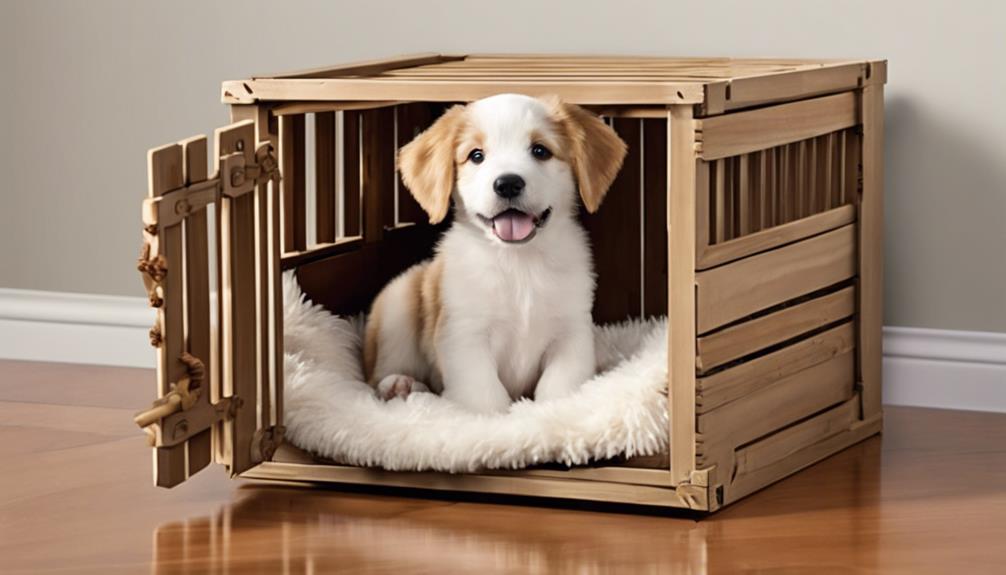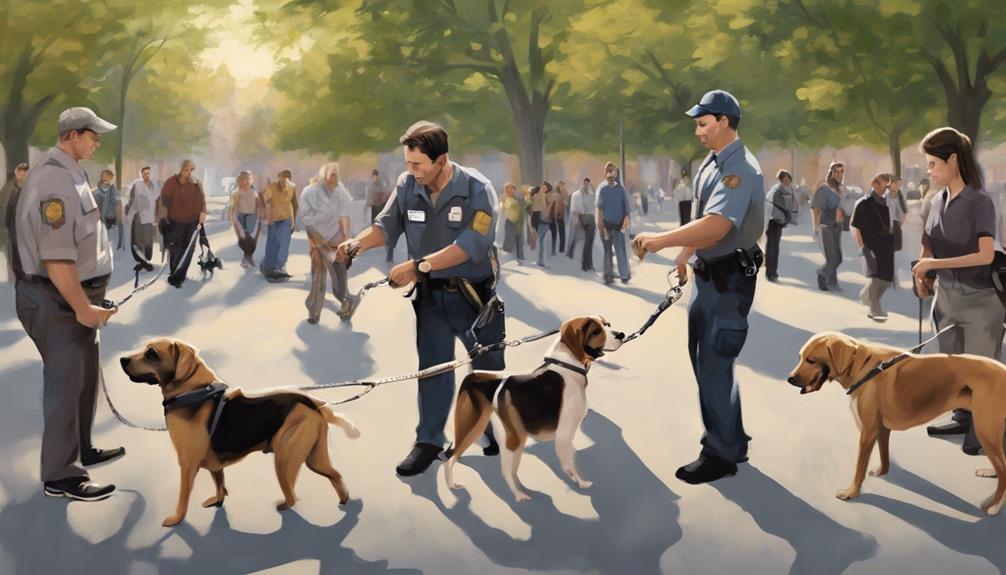When training 4-month-old puppies using crate training, it is important to prioritize the correct crate size and type, establish a consistent routine, use high-value treats, and be alert for signs of discomfort. Ensuring the puppy has enough space to move comfortably, following a regular schedule, rewarding good behavior with tasty treats, and being attentive to any signs of unease or stress during crate time are key elements for successful training.
By focusing on these fundamentals, you can set your puppy up for crate training success right from the start.
Key Takeaways
- Choose a wire crate with secure latches for durability and safety.
- Establish a consistent daily crate schedule for positive associations.
- Use high-value treats like cooked chicken to reinforce good behavior.
- Supervise crate time closely and observe signs of discomfort.
- Gradually increase crate time by 15-30 minutes daily for acclimation.
Crate Selection Tips
When selecting a crate for your 4-month-old puppy, prioritize choosing one that allows for ample space for standing up, turning around, and comfortably lying down. A wire crate is often a popular choice due to its durability and the ability to provide proper ventilation for your puppy.
It's essential to ponder the size of the crate, ensuring that it accommodates your puppy's current size while also allowing room for growth. Opt for a sturdy crate with secure latches to prevent any escape attempts by your energetic puppy.
Look for a crate that features a removable divider, allowing you to adjust the space as your puppy grows, making it a versatile option for crate training. By selecting a crate that meets these criteria, you can create a comfortable and safe environment for your puppy to aid in their crate training process effectively.
Establishing a Crate Routine
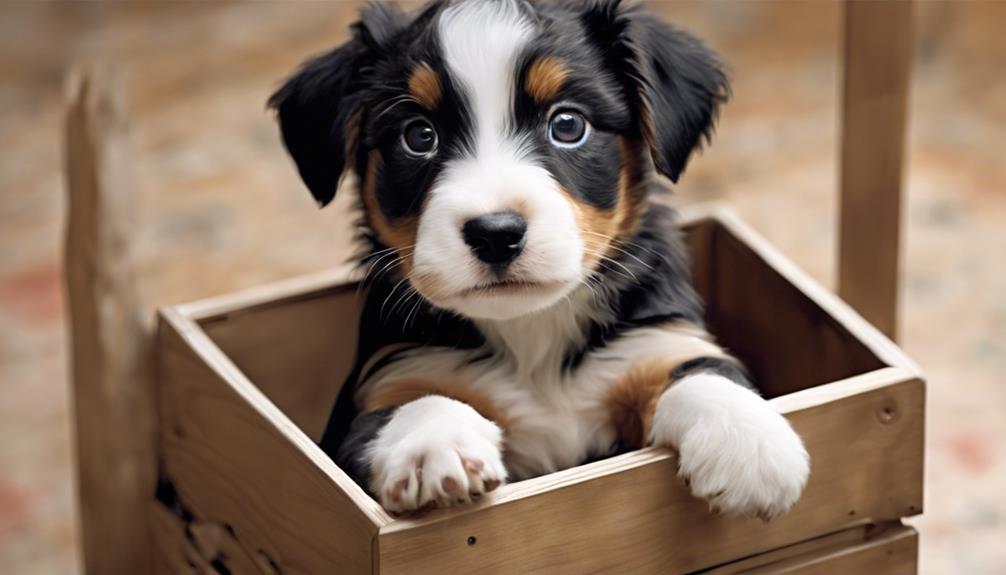
Let's discuss the importance of establishing a daily crate schedule and fostering positive crate associations for your 4-month-old puppy.
Consistency in crate training times can help regulate your puppy's bathroom breaks and guarantee they feel secure in their routine.
Using treats and praise when introducing your puppy to the crate can create a positive association, making the crate a welcoming and safe space for your furry friend.
Daily Crate Schedule
Creating a structured daily routine is essential for successful crate training of your 4-month-old puppy. Establish a consistent schedule that includes set times for confinement, elimination, exercise, and supervised crate time.
Plan for potty breaks after meals and during shifts to help your puppy learn proper elimination habits. Integrate engaging activities into the daily routine to make crate training a positive experience.
By maintaining a structured rhythm in your puppy's daily crate schedule, you'll help them adapt to the routine and feel secure in their crate. Consistency is key in establishing good behaviors and ensuring your puppy feels comfortable and safe in their crate.
Stick to the schedule to achieve effective results in your crate training efforts.
Positive Crate Association
To establish a positive crate association for your 4-month-old puppy, start by introducing the crate as a welcoming and comfortable space with treats and toys. This will help create a positive association with the crate.
Including mealtime or treats inside the crate as part of a consistent routine will reinforce positive experiences. Using a cue word or command when introducing your puppy to the crate will make the process smoother and more predictable.
Gradually increasing the time spent in the crate will help your puppy adjust to longer periods of confinement. It's crucial to maintain the crate as a safe and cozy space by providing comfortable bedding, toys, and familiar scents to promote relaxation and security for your puppy.
Incorporating High-Value Treats
When it comes to crate training our 4-month-old puppies, incorporating high-value treats plays a vital role in motivating and rewarding them.
By selecting treats like cooked chicken or cheese that the puppy finds irresistible, we can effectively reinforce positive behavior.
The variety in rewards helps keep the training sessions engaging and guarantees the puppy remains enthusiastic to participate.
Treat Motivation Importance
Incorporating high-value treats during crate training for a 4-month-old puppy is essential for fostering motivation and positive reinforcement. High-value treats like freeze-dried liver, cooked chicken, or specialized training treats can greatly increase a puppy's interest in crate training.
These treats help create positive associations with the crate, making the training process more effective and enjoyable. Rewarding a 4-month-old puppy with high-value treats for displaying calm behavior in the crate reinforces desired behaviors and encourages a positive attitude towards training.
Reward Variety Selection
We can enhance a 4-month-old puppy's crate training experience by strategically selecting a variety of high-value treats to reinforce positive behaviors.
- Diverse Treat Options: Incorporate high-value treats like cooked chicken, cheese, or freeze-dried liver to keep the puppy engaged and motivated during crate training sessions.
- Prevent Habituation: By rotating different types of treats, we can prevent habituation and maintain the puppy's interest, leading to more effective training outcomes.
- Individual Preferences: Select treats that are small, easy to chew, and highly appealing to the puppy. Varying the treats helps in finding the most effective rewards that cater to the individual preferences of your 4-month-old puppy.
Consistent Mealtime Crating
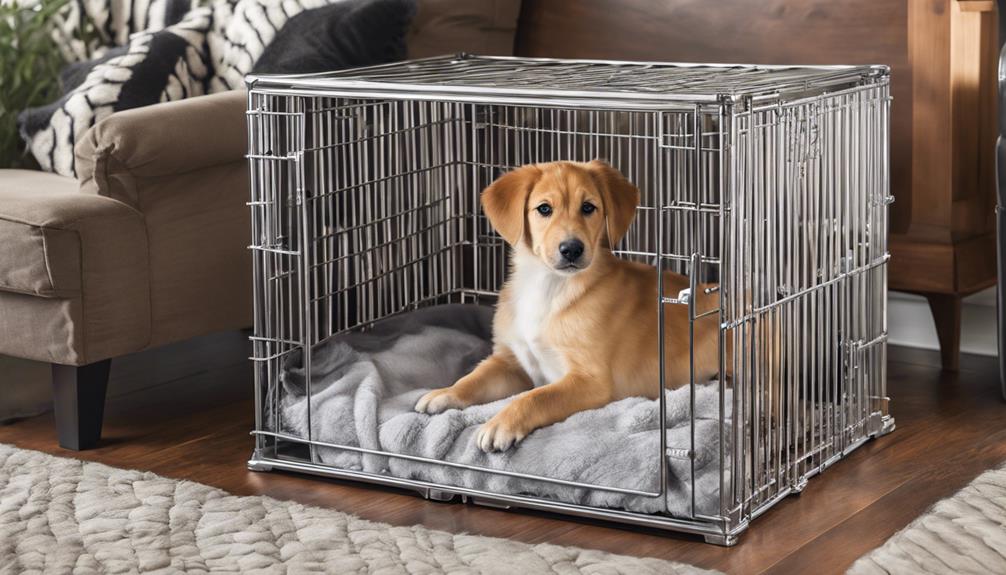
Establishing a regular mealtime crating routine for your 4-month-old puppy is crucial for creating positive associations with the crate and aiding in housebreaking. By crating your puppy during meal times, you aren't only setting a routine but also helping them connect the crate with something positive – food. This practice can also help in regulating your puppy's potty schedule, making housebreaking more manageable.
Mealtime crating guarantees that your puppy stays focused on eating without distractions, promoting healthy eating habits. Additionally, a consistent mealtime crating routine can help your puppy learn to settle down and relax in the crate, as they start associating it with a calm and enjoyable experience. Remember to make mealtime in the crate a pleasant and stress-free time for your puppy to strengthen this positive association.
Implementing Cue Words
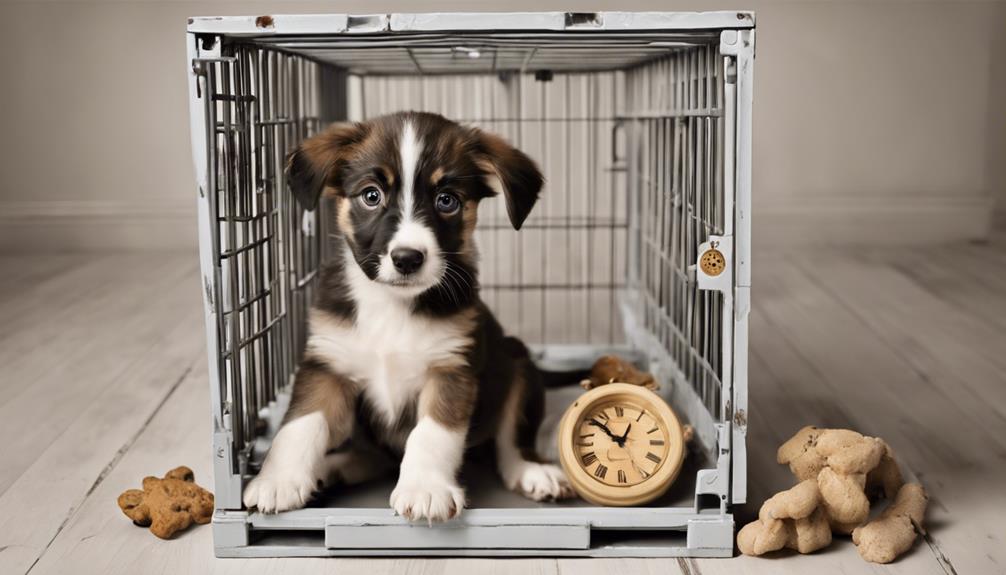
To enhance your 4-month-old puppy's crate training experience, introduce consistent cue words such as 'crate time' or 'kennel up' to establish a clear command for entering the crate. This simple yet effective method can greatly improve communication between you and your puppy during training.
Here are some key points to keep in mind:
- Improved Communication: Cue words help your puppy understand what's expected of them, making the training process more effective and efficient.
- Establishing Routine: By consistently using cue words like 'crate time,' you can create a positive routine for your puppy, signaling when it's time to go into the crate.
- Building Confidence and Security: Implementing cue words in crate training can help your puppy feel more secure and confident in their crate, leading to a more successful training experience overall.
Supervising Crate Time

When supervising crate time for a 4-month-old puppy, we need to be mindful of the timing to make sure they aren't crated for too long.
It's important to observe the puppy's behavior cues while they're in the crate, looking for signs of distress or discomfort.
Correcting any misbehaviors promptly and appropriately can help reinforce positive crate training habits.
Timing of Supervision
During the early phases of crate training for a 4-month-old puppy, it's essential to supervise their time in the crate for short periods to ensure their comfort and well-being.
Here are key points to take into account:
- Start Small: Begin with brief supervised sessions in the crate to help the puppy acclimate gradually.
- Increase Time Gradually: As the puppy grows accustomed to the crate, extend the supervised periods to build their comfort level.
- Monitor Behavior: Keep a close eye on your puppy's behavior and comfort while in the crate to address any signs of anxiety or distress promptly.
Behavior Observation Cues
Observing your 4-month-old puppy's behavior cues while they are in the crate is essential for ensuring their comfort and well-being during the training process. When supervising crate time, pay attention to signs of discomfort or anxiety. Look for behaviors such as pacing, whining, barking, or excessive drooling as cues for distress. Monitor their body language for stress indicators like ears back, tail tucked, or excessive panting. Be alert to any attempts to escape the crate or destructive behavior, which can indicate distress. Additionally, note any behavior changes or vocalizations as these could signal underlying issues. By observing these behavior cues closely, you can address any issues promptly and create a positive crate training experience for your puppy.
| Signs of Discomfort | Puppy Behavior |
|---|---|
| Pacing | Whining |
| Excessive Drooling | Barking |
| Ears Back | Tail Tucked |
| Panting | Escape Attempts |
Correcting Misbehaviors
To effectively correct misbehaviors during crate training for 4-month-old puppies, close supervision is essential for prompt intervention and positive reinforcement techniques. When supervising crate time, consider the following:
- Use Positive Reinforcement: Reward good behavior with treats or praise to encourage desirable actions.
- Monitor Behavior Closely: Keep a watchful eye on your puppy in the crate to catch any undesirable behaviors early.
- Intervene Promptly: If your puppy displays whining, barking, or destructive behavior, address it with gentle correction and redirect their focus.
Consistent supervision during crate training not only helps correct misbehaviors effectively but also sets the foundation for a well-behaved and happy pup.
Gradual Time Extension
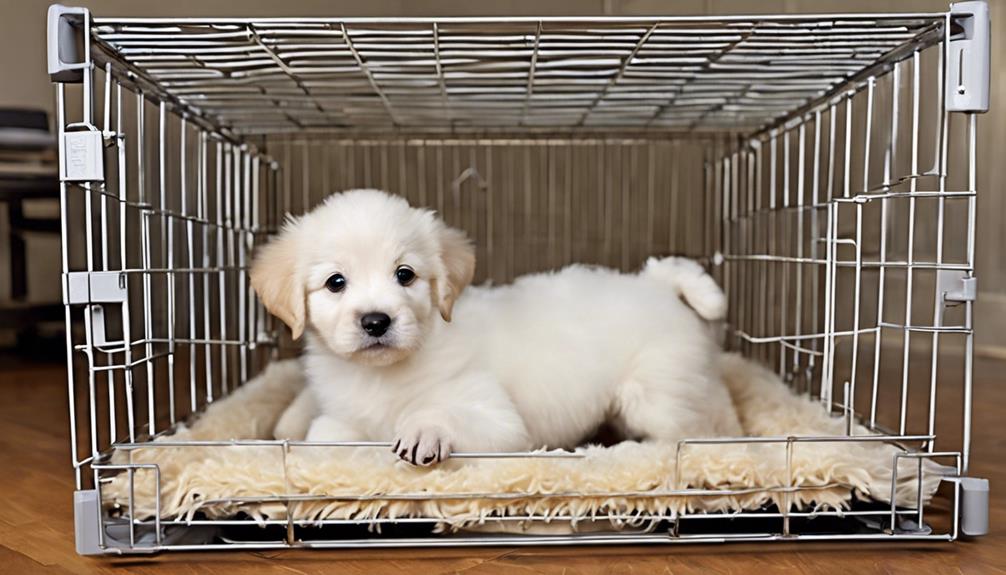
As we gradually extend crate time for a 4-month-old puppy, it's important to increase the duration by 15-30 minutes each day to facilitate a smooth adjustment process. This incremental approach helps the puppy acclimate to spending more time in the crate without feeling overwhelmed. It's vital to monitor the puppy's behavior closely during this time to make sure they're comfortable and not exhibiting signs of distress or anxiety.
Incorporating engaging toys or treats inside the crate can help keep the puppy entertained and relaxed while inside. Positive reinforcement, such as praise and treats, should be used when the puppy remains calm and content in the crate. This will help create positive associations with being in the crate.
Gradually building up the duration of time spent in the crate is key. It's advised to work towards leaving the puppy in the crate for longer periods, up to 4-5 hours at a time, taking into account the individual needs and progress of the puppy. By adjusting gradually and using positive reinforcement techniques, the crate training experience can be successful and beneficial for both the puppy and the owner.
Positive Reinforcement Techniques

Using high-value treats and praise is a key strategy to reinforce desired behaviors when introducing your 4-month-old puppy to the crate. Positive reinforcement techniques play an important role in crate training, making it a positive experience for your puppy.
Here are some effective methods to implement positive reinforcement:
- High-Value Treats: Offer your puppy irresistible treats whenever they enter the crate voluntarily. This creates a positive association with the crate, encouraging them to view it as a safe and rewarding space.
- Special Toy or Chew: Incorporate a special toy or chew inside the crate to make it more enticing for your puppy. This can help keep them occupied and engaged while inside, associating the crate with fun and comfort.
- Consistency: Consistency is vital when using positive reinforcement techniques. Make sure you always reward your puppy immediately after they enter the crate to reinforce the behavior. Consistent positive reinforcement helps your puppy learn faster and builds trust between you and your furry companion.
Entertainment in the Crate
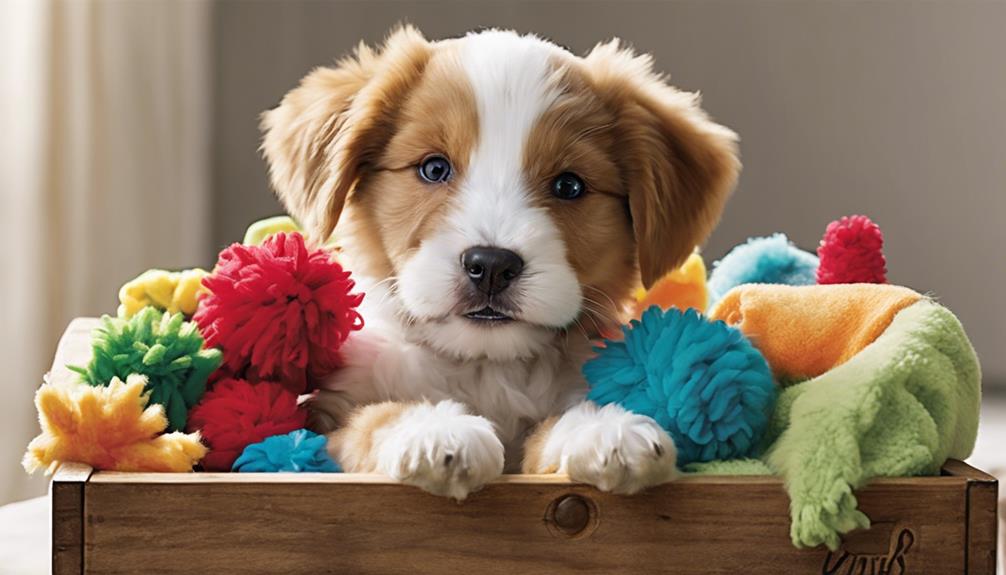
One effective way to keep a 4-month-old puppy entertained in the crate is by providing interactive toys like KONGs stuffed with treats. These toys engage the puppy mentally and provide a positive association with the crate. Puzzle feeders or food-dispensing toys are also great options to keep your puppy stimulated while crated. By incorporating these toys, you can prevent boredom and encourage your puppy to enjoy their crate time.
To further enhance your puppy's entertainment in the crate, consider rotating their toys regularly. This helps maintain their interest and guarantees they stay engaged. Additionally, offering chew toys or bones can satisfy your puppy's natural urge to chew, promoting good behavior and keeping them occupied.
| Type of Toy | Purpose | Examples |
|---|---|---|
| Interactive Toys | Mental stimulation | KONGs, treat-dispensing toys |
| Puzzle Feeders | Engaging activities | Snuffle mats, puzzle balls |
| Chew Toys | Satisfy chewing needs | Nylon bones, rubber toys |
Monitoring Break Signals

To monitor break signals in your 4-month-old puppy effectively, observe for signs of restlessness, sniffing around, or circling as potential indicators of needing a break. When it comes to monitoring break signals in your puppy, be attentive to the following cues:
- Increased Whining: If your puppy starts whining more than usual, it could be a sign that they need a break to relieve themselves.
- Pacing: Watch out for pacing behavior, as this could indicate that your puppy is feeling antsy and may need to go outside for a potty break.
- Body Language: Pay close attention to your puppy's body language. If you notice them sniffing around or heading towards the door, it's likely time for a bathroom break.
Frequently Asked Questions
Should a 4 Month Old Puppy Sleep in a Crate?
Yes, a 4-month-old puppy should sleep in a crate. It helps with potty training and establishing a routine. Gradually increase crate time to prevent accidents. We monitor comfort and adjust crate time to confirm the puppy's well-being.
How Do You Crate Train a 4 Month Old Puppy at Night?
We establish a consistent routine, gradually increasing crate time overnight. Providing a cozy environment with familiar items, we take the puppy out for a bathroom break before bedtime and use positive reinforcement for good habits.
Is 4 Months Too Late to Train a Puppy?
Certainly! Training a 4-month-old puppy is not too late. They are still in a critical learning period and receptive to new behaviors. Consistency and patience are key. Positive reinforcement techniques work well to encourage good behavior.
Why Won't My 4 Month Old Puppy Stop Crying in the Crate?
We empathize with the frustration when a 4-month-old puppy won't stop crying in the crate. To address this, create a comfortable environment, use positive reinforcement, and gradually increase crate time. Consistency and patience are key for successful crate training.
Conclusion
To wrap up, crate training for 4-month-old puppies can be a rewarding experience with the right approach. By following the tips outlined, such as selecting the right crate, establishing a routine, and using positive reinforcement, you can help your puppy feel comfortable and secure in their crate.
Remember, Rome wasn't built in a day, so be patient and consistent in your training efforts. With time and effort, your puppy will learn to love their crate as a safe and cozy space.
